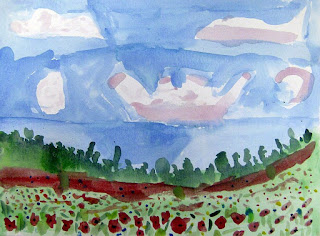 |
| Still Life with Guitar, 1921 |
There is no abstract art. You must always start with something. Afterward you can remove all traces of reality. ~ Pablo Picasso
We think of Picasso as an abstract artist or a cubist (or both). In reality he was a very proficient artist who chose to play with his subjects as a child would. He said, "It takes a long time to become young," and it is obvious that he was constantly working on it!
 I decided on a Picasso-style guitar because it is a familiar, popular subject, and because he painted many guitars, mandolins, and violins, all in the style you see above.
I decided on a Picasso-style guitar because it is a familiar, popular subject, and because he painted many guitars, mandolins, and violins, all in the style you see above.  Also, this project could easily be created as a collage, which gave us a break from painting. As Picasso style art, they could mix and match elements without worrying about making things match up or perfect or even or straight, etc.
Also, this project could easily be created as a collage, which gave us a break from painting. As Picasso style art, they could mix and match elements without worrying about making things match up or perfect or even or straight, etc. We drew nothing. We simply cut out or tore the shapes freehand and assembled all the parts.

We started by creating the guitar from two guitar-ish shapes that did not necessarily match up from different types of paper. We cut out a neck, and we glued the guitar together. Some of us pretended to play our guitars before moving on.

We placed them on our substrate (14" x 18" poster board) and arranged other elements around and beneath them. Nothing was glued down until the composition looked interesting, balanced, and complete.

After gluing, we added drawn elements and details, such as outlining, textures, shadows, and shapes - like zigzags, which gave some guitars an "electric guitar" feel. We used metallic Sharpies for most of our detail work.
I think they are all awesome!
 |
| My sample |
Our thanks to Meri Cherry for this very cool art project idea!

















































